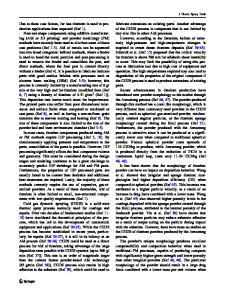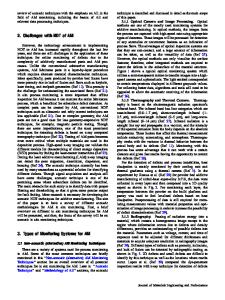Fatigue Life of Titanium Alloys Fabricated by Additive Layer Manufacturing Techniques for Dental Implants
- PDF / 1,750,096 Bytes
- 13 Pages / 593.972 x 792 pts Page_size
- 96 Downloads / 312 Views
TRODUCTION
ADDITIVE layer deposition is a rapid prototyping manufacturing technique,[1,2] which is often referred to as additive layer manufacturing (ALM), selective laser melting (SLM), solid free-form fabrication, and 3D printing. This fabrication technique processes a part through a gradual building of solid materials from powder layers to the required shape using profiles created using computer-aided design (CAD), X-ray computer tomography (CT), or magnetic resource imaging (MRI) scanning.[1,2] Layered deposition can be achieved by laser beam melting (LBM) or electron beam melting (EBM). During additive layer manufacturing, powder or wire is fed into a melt pool that is produced by a sharply focused laser or electron beam. Parts are built layer by layer by rastering the laser or electron beam and a powder source across the substrate.[3–9] These methods require almost no fixtures or tooling. As such, a considerable reduction in the production cost and lead time can be achieved. The capabilities of these fabrication methods have been KWAI S. CHAN, Institute Scientist, is with the Mechanical Engineering Division, Southwest Research Institute, San Antonio, TX 78238. Contact e-mail: [email protected] MARIE KOIKE, formerly with the Baylor College of Dentistry, Texas A&M Health Science Center, Gaston Ave, Dallas, TX 75246, is now Assistant Professor with Nippon Dental University School of Life Dentistry, Tokyo, Japan. ROBERT L. MASON, Institute Analyst, is with the Fuels and Lubricants Research Division, Southwest Research Institute. TORU OKABE, Retired, formerly with the Baylor College of Dentistry, Texas A&M Health Science Center. Manuscript submitted January 20, 2012. Article published online October 17, 2012 1010—VOLUME 44A, FEBRUARY 2013
published in the literature.[3–9] The microstructure and mechanical properties of fabricated materials or prototype products including aerospace components,[10] industrial parts,[11] medical devices,[12] and dental prostheses[12–14] have been investigated. For example, in studies by Murr et al.,[12,13] titanium and titanium alloys have been considered to make medical and dental prostheses using these additive layer manufacturing technologies. Since the use of an inert gas or a vacuum is a necessity for a quality laser and electron beam fabrication, layered deposition is ideal for fabricating titanium components which are susceptible to oxidization in air. The microstructure and mechanical properties such as yield strength, ultimate tensile strength, and ductility of additive layer manufactured alloys have been reported by several investigators.[3–9,12–17] The presence of porosities and/or unmelted regions in laser-formed Ti and TiAl-alloys due to lack of fusion has been reported by Kobryn and Semiatin,[4] Murr et al.,[5,6] and Thijs et al.,[7] and by Brandl et al.[9] for an Al alloy. These types of pores and unmelted powders in ALM materials, which primarily form between layers and are aligned along the interlayer direction, have been attributed to non-optimized build parameters[7,9]
Data Loading...











